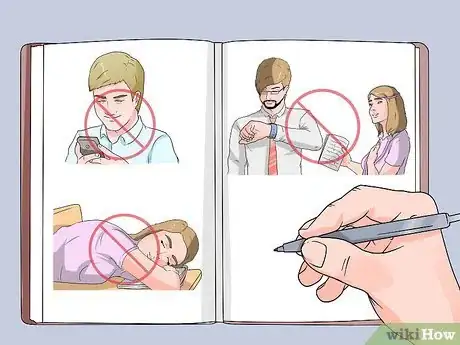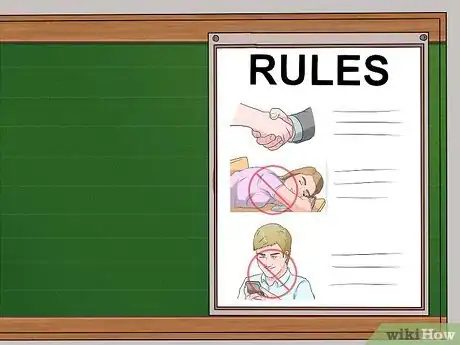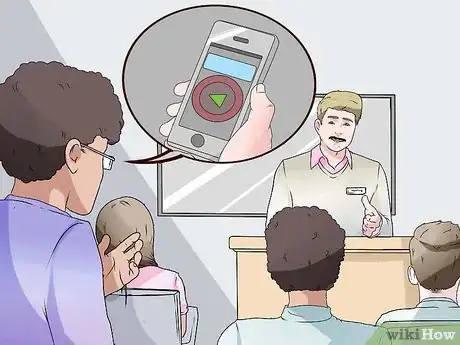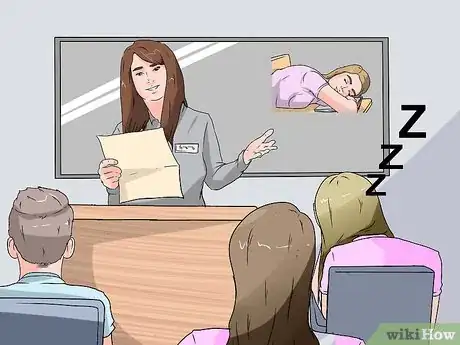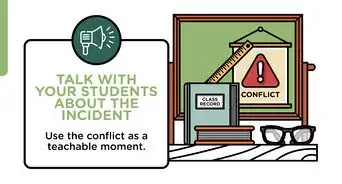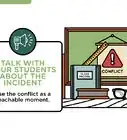This article was co-authored by Emily Listmann, MA. Emily Listmann is a private tutor in San Carlos, California. She has worked as a Social Studies Teacher, Curriculum Coordinator, and an SAT Prep Teacher. She received her MA in Education from the Stanford Graduate School of Education in 2014.
There are 7 references cited in this article, which can be found at the bottom of the page.
This article has been viewed 74,567 times.
Creating a classroom contract or a list of classroom rules can help bring order to your classroom by establishing a clear set of expectations and consequences for not meeting those expectations. Being specific and consistent will help you achieve the best results. Allowing your students to contribute to the process of establishing the classroom rules may also help them feel more motivated to follow them.
Steps
Deciding on the Standards
-
1Start by making a list of unacceptable behaviors. If you're not sure where to start with your classroom rules, you can begin by simply writing down all of the specific behaviors that you want to discourage your students from engaging in. Then use this list to craft your rules. [1]
- Use the specific actions you came up with to develop more general rules. For example, if you don't want your students to talk out of turn or use cellphones during class, your rule could be "be respectful of the teacher."
-
2Focus on goals. Instead of centering your classroom contract around rules, which typically state actions that are prohibited, give your students something to work towards by establishing goals. The goals can be broad statements such as "treat everyone with respect." This goal inherently prohibits behavior like hitting and name calling without having to spell out each undesired behavior.[2]Advertisement
-
3Keep it positive. If you do need to establish specific rules beyond your broader goals, try to use positive language. This will help motivate students to meet the expectations, rather than bombarding them with prohibited activities.
- For example, "Keep your work stations neat" is a better rule than "Don't make a mess."
-
4Make the expectations simple. It's extremely important that your students understand what is expected of them, or else they will never be able to follow the rules. When crafting your rules, do your best to make them clear and concise, while leaving no room for misinterpretation.
- Avoid using confusing words that your students may not know.
- If your rule seems vague, be sure to give examples so your students understand what it means.
-
5Separate different kinds of rules and expectations. It's important to recognize that the expectations you have of students fall into multiple categories. You may choose to include rules from multiple categories in your contract, but be sure that students understand the different categories. This will make it much easier for them to understand what is expected of them.
- Behavior rules include things like "be respectful" and "be safe."
- Academic expectations include things like "turn your homework in on time" and "cite your sources."
- Learning expectations focus more on helping students think deeply and take responsibility for their own learning. Examples include "ask questions when you don't understand" and "challenge yourself."
-
6Ask other teachers if you can look over their classroom contracts. Talk to them about what works best in their classroom, as well as what hasn't worked. Not only will this give you ideas about what to include in your classroom contract, it can also prevent discrepancies between classrooms that could create conflict, as students will favor a more permissive teacher.
- It's better for both students and teachers if there are uniform expectations across classrooms. This will provide the students with a stable, clearly structured learning environment.
Involving Students in the Process
-
1Establish the basic vision. While you may want to allow your students to contribute to the classroom rules, it's important to provide the framework for their ideas. Start by telling your students about the goals you have for them or your vision for the classroom. Then ask them to contribute by suggesting specific behaviors that can help support these goals.[3]
- Providing this framework will help ensure that your students do not come up with rules that you do not agree with or that are not conducive to a positive learning environment.
- For example, if your goal is that everyone will be respected, your students may suggest that everyone wait their turn to speak or that everyone consider other people's feelings before saying something.
- Remind students to focus on positive rules, rather than negative rules.
-
2Consider asking for feedback on problems. In addition to encouraging students to brainstorm ideas for meeting the classroom goals, you can also ask them to share some of the challenges they face in school. They may identify problems, such as bullying or distractions in the classroom, which are interfering with their ability to learn.[4]
- Once they identify problems, try having students brainstorm potential solutions to those problems.
- If you have students do this, be sure to show them that you value their input by incorporating at least some of the ideas they came up with into the classroom contract.
- You may want to consider having students vote on the rules that everyone comes up with an/or giving everyone the opportunity to suggest that a rule be eliminated.[5]
-
3Encourage the use of "I" statements. Help your students take ownership of the rules that they create by having them use first person pronouns. This will make it more clear to them that they are each individually responsible for upholding the rules.[6]
- For example, instruct them to write "I will consider other people's feelings" instead of just "consider other people's feelings" or "everyone should consider each other's feelings."
- You can also have them make a list of their rights. This may include things like "I have the right to express my opinion" or "I have the right to feel safe at school." This can help them identify problems that need solutions.
-
4Have students sign the rules or contract. Once you have finished your discussion and put your contract in writing, have each student sign it. This will symbolize that each student is agreeing to abide by the rules.[7]
- You may want to give each student a separate copy or have everyone sign the classroom copy.
- You may also wish to send a copy of the classroom contract home with each student to be signed by a parent or guardian. This will help promote parental involvement in your classroom.
-
5Display the rules prominently. Make a poster or write the classroom rules on the board. No matter how you choose to display them, make sure they are always visible to students.
- If you are having problems with behavior in your classroom, you can try asking the students to re-read the classroom contract. Having it displayed prominently will make this much easier.
-
6Be open to change. Your classroom rules and expectations should never be set in stone. You may find that the rules need to be adjusted as the year progresses, so always be willing to make necessary changes.[8]
- Discuss any changes you make with your students so that they understand what the changes are and why they were made.
- Listen to your students' feedback on the rules. They may recognize before you do that a rule needs to be reworked because it isn't supporting the classroom goals.
Enforcing Your Rules
-
1Consider the school's policies. Some schools have very structured policies regarding the consequences that a student should face for breaking the rules. Others have general guidelines, but give teachers more freedom to decide on the appropriate consequences. As you are establishing your classroom rules or contract, be sure to consider the policies that are already in place at your school, and make sure your classroom rules complement them. [9]
- Do not make exceptions to school-wide policies. For example, if your school prohibits all cell phone use, do not state in your contract that cell phone are allowed at certain times.
-
2Clearly outline the consequences. In addition to outlining the expectations you have of your students, it is important to let them know what the consequences will be if they do not meet those expectations. There should never be any surprises when it comes to punishment.
- Make it clear if there will be a warning for the first offence. Keep in mind that this may be appropriate for some behaviors (like talking out of turn), but not for others (like hitting another student).
-
3Make sure the consequences are appropriate. Think carefully about how you will punish students for breaking the rules, and make sure that the punishment fits the offence. You should not punish minor offences too seriously, nor should you fail to respond adequately to major infractions.[10]
- Especially for younger children, the consequences should be immediate and directly related to the offence. They may have a more difficult time understanding the relationship between an action and a punishment if the punishment is delayed.
- Consequences are not only meant to punish the student who is breaking the rules, but also to prevent that student from disrupting the class. For example, if two students are talking to each other during a lesson, separating them will both punish them and prevent them from further distracting their classmates. Giving them after school detention will punish them, but it will not remedy the immediate problem.
-
4Refer students who break the rules back to their contract. Remind them that they signed the contract. Then have them identify which rule they broke. Ask them to articulate why this rule is important. Finally, have them identify what the consequence for breaking the rule is.
-
5Treat all students equally. When establishing rules and consequences in your classroom, it's important to be mindful about implementing them consistently. All undesirable behavior should be dealt with in the same way, whether it comes from the worst student in class or the best.
- Singling out "bad kids" will only make their behavior worse, so try to make them feel like they are the same as every other student in the class.
-
6Reward students for making good choices. Try not to focus so much on punishing students for bad behavior that you forget to reward them for meeting your expectations. Be sure to praise students for good behavior as well.[11]
- Don't rely too heavily on external rewards, like stickers or pizza parties, as the students' interest in these rewards will eventually fade. The most motivating incentive for students to follow the classroom rules is the opportunity to be a part of a great classroom community.
Expert Q&A
-
QuestionCan these rules be used for a tutorial center?
 Emily Listmann, MAEmily Listmann is a private tutor in San Carlos, California. She has worked as a Social Studies Teacher, Curriculum Coordinator, and an SAT Prep Teacher. She received her MA in Education from the Stanford Graduate School of Education in 2014.
Emily Listmann, MAEmily Listmann is a private tutor in San Carlos, California. She has worked as a Social Studies Teacher, Curriculum Coordinator, and an SAT Prep Teacher. She received her MA in Education from the Stanford Graduate School of Education in 2014.
Test Prep Tutor Absolutely! It's a good idea to adapt some of the suggestions to better fit with your tutoring organization's expectations or your goals as a tutor. In general, this guide will be helpful for any type of classroom environment.
Absolutely! It's a good idea to adapt some of the suggestions to better fit with your tutoring organization's expectations or your goals as a tutor. In general, this guide will be helpful for any type of classroom environment.
References
- ↑ http://www.smartclassroommanagement.com/2015/07/18/how-to-create-the-perfect-set-of-classroom-rules/
- ↑ http://thecornerstoneforteachers.com/free-resources/behavior-management/class-rules
- ↑ http://www2.peacefirst.org/digitalactivitycenter/system/files/activities/files/classroom_contract_tipsheet.pdf
- ↑ http://www.theteachertoolkit.com/index.php/tool/classroom-contract
- ↑ http://www.proteacher.org/c/180_Classroom_Rules_-_Involving_Students.html
- ↑ https://www1.umn.edu/humanrts/edumat/hreduseries/TB5/PDFs/lifting_unit1.pdf
- ↑ http://www2.peacefirst.org/digitalactivitycenter/system/files/activities/files/classroom_contract_tipsheet.pdf
- ↑ https://whatedsaid.wordpress.com/2014/01/26/10-tips-for-creating-a-class-agreement/
- ↑ http://thecornerstoneforteachers.com/free-resources/behavior-management/class-rules
